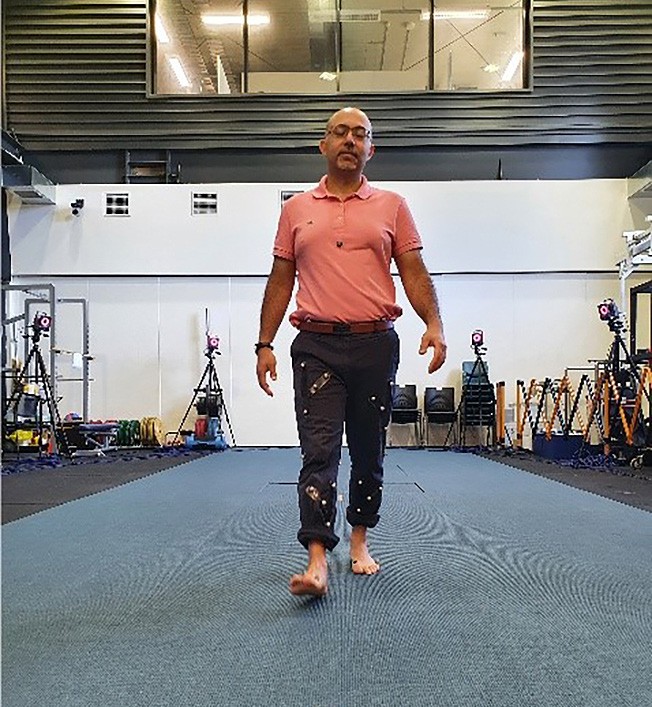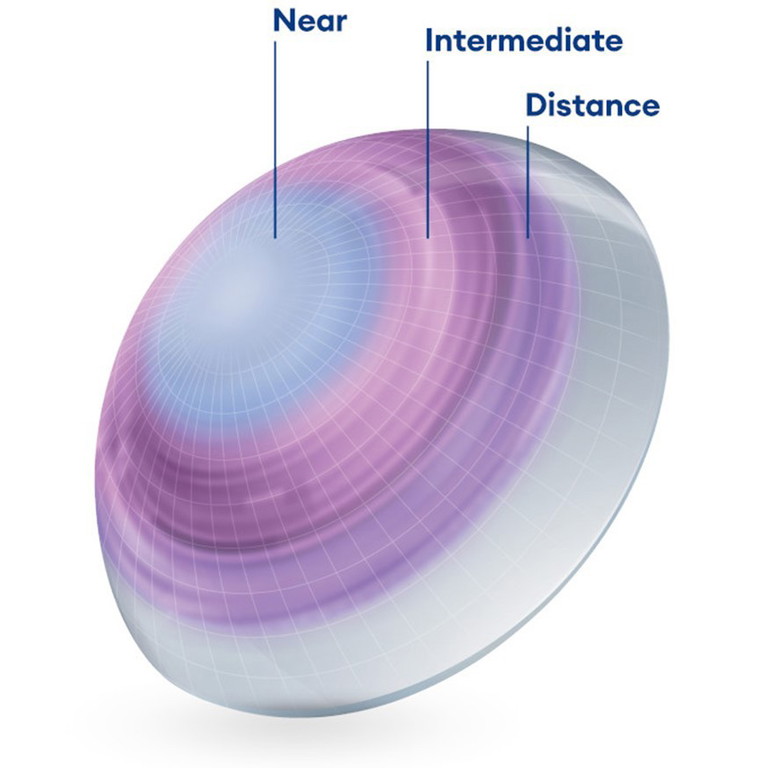mieducation
education
Caring for your Presbyopes:
The Option of Multifocal Contact Lenses
Multifocal contact lenses provide numerous benefits to presbyopic patients, but with optometrists often working in busy clinics, streamlining the fitting process and optimising the success rate is of great importance. This article explores the potential benefits of multifocal contact lenses for patients and provides guidance on how to streamline and optimise the fitting process.
LEARNING OBJECTIVES
On completion of this CPD activity, participants should:
1. Understand how presbyopia can impact quality of life,
2. Be aware of how multifocal contact lenses can benefit presbyopic patients,
3. Realise the importance of following a fitting guide when fitting contact lenses, and
4. Understand the key factors for fitting success with Alcon multifocal contact lenses.
WRITERS Helen Gleave and Associate Professor Faran Sabeti
When discussing presbyopia, it is important to realise the condition can be impactful, not only to patient quality of life but also emotionally. Presbyopia can be the first real sign of ageing, and it cannot be avoided or mitigated with treatments or creams. One study reviewed social media sources to understand how individuals described their experience of presbyopia.1 More than 4,500 posts were identified in four months and, in addition to discussing the challenges of reading, other impacts such as eye strain, headaches, and limitations in sport and leisure activities were cited. The emotional impact was discussed too, with feelings of sadness, anger, and fear reported. One presbyope commented, “I find for walking that if I don’t wear contacts, I find it harder judging where the ground is on rough terrain, so the contacts help with that too”.1
This emphasises that presbyopia is not trivial for the patient. Having proactive discussions about presbyopia ahead of time may facilitate a smoother transition to presbyopic correction. Educating the patient about early signs and symptoms, discussing presbyopia in relation to existing refractive error, and presenting all available corrective options can create a base from which meaningful discussions about the option of presbyopic correction can occur.2
WHAT DO PRESBYOPIC PATIENTS NEED?
When the moment comes to address the patient’s presbyopic correction, take time to understand who the patient is, and to understand their visual and lifestyle needs at work, at home, and socially. A patient is a whole person, not just their prescription. By listening to their experience and uncovering the frustrations they are experiencing, advice on vision correction options can be tailored to their individual needs. Keep in mind that more than one vision correction option may be the best answer for their vision correction needs. Multifocal, occupational, and single vision glasses, multifocal and distance contact lenses, plus over-spectacles can be used in combination.
The research tells us that including the option of multifocal contact lenses has many benefits for presbyopes.1,3 Patients who require good near vision or distance vision in different directions of gaze, for example various occupations or sports, in addition to those simply not wanting to reach for reading glasses, are those who easily come to mind. Another benefit recently investigated by the co-author of this article – Associate Professor Faran Sabeti from University of Canberra – is the effect on physical mobility.
HOW DO MULTIFOCAL CONTACT LENSES IMPACT PHYSICAL MOBILITY?
The collaborative study, across the disciplines of optometry, physiotherapy, and psychology at the University of Canberra, supported by Alcon Australia, evaluated the interaction between visual function and physical mobility with Total1 Multifocal soft contact lenses (soft MF CL).
The results showed that while both soft MF CL and spectacle correction types influenced balance and gait, contact lenses offered advantages for movement stability. Addition (add) power was also a significant factor affecting mobility.
Clinicians may need to carefully balance the add power prescribed in multifocal lenses to optimise both visual acuity and comfort, especially for patients who prioritise dynamic mobility and spatial awareness in their daily routines. This is supported by the Alcon fitting guide, which recommends utilising the lowest acceptable add for functional vision when fitting Total1 Multifocal lenses, and to begin optimising vision by the addition of spherical power to distance vision while keeping the add fixed.
James Enright,* one of the study participants, was a gym manager in his late 50s who wanted to trial multifocal contact lenses for many years but was apprehensive about using them. He was a spectacle wearer since childhood but was becoming increasingly dissatisfied with the limitations of spectacles to achieve optimal vision in his workplace. He was in good health with no history of allergies. His baseline examination revealed that he was an anisometropic hyperopic astigmat with the following subjective refractive error: RE +3.50/-0.25x90;
LE +5.50/-0.75x85; Add +2.00. His best corrected visual acuity (BCVA) achieved RE 6/6; LE 6/6. Following the fitting guide, he was fitted with a Total1 Multifocal that achieved centrally fitting, full coverage, with adequate movement upon first installation.
“I find for walking that if I don’t wear contacts, I find it harder judging where the ground is on rough terrain, so the contacts help with that too”
The fitting guide recommends beginning with the same-day spectacle prescription for all new and refit patients and adding +0.25 to the most plus vertex-corrected spherical equivalent prescription for each eye. Therefore, we started with RE +3.50 (6/6); LE+5.50 (6/7.5) and, following addition of loose +0.25 trial lenses, determined that the most plus power accepted was RE +3.75 (6/6); LE +5.75 (6/7.5).
Next, the fitting guide recommends determining the lowest acceptable add for functional vision. For Mr Enright, this was achieved with a high add in each eye. His near acuity with soft MF CL measured RE 6/9; LE 6/12. We then proceeded to complete the teach. He successfully inserted and removed the lenses, and we scheduled a follow-up review in one week.
Prior to beginning contact lens wear, Mr Enright also completed a baseline assessment of balance and gait, including a number of quality of life (QoL) surveys such as the Modified Gait Efficiency Scale, the Contact Lens Impact on Quality of Life Questionnaire and the National Eye Institute Visual Function Questionnaire. After one week he returned to the clinic for review and reported that he was very pleased with the visual performance of the contact lenses at both distance and near. His BCVA at distance with contact lenses measured RE 6/6; LE 6/7.5.
Again, the fitting guide recommends distance over-refraction, with both eyes open, and with lenses hand-held on each eye separately, adding +0.25 steps until blur is reported. The add is kept the same. We settled on the same contact lens prescription that was initially prescribed and continued contact lens wear full time for three months. All baseline tests were repeated at his final three-month assessment, and he continued to be satisfied with the vision and comfort of the lenses. His BCVA measured distance RE 6/6; LE 6/7.5 and near RE 6/9; LE 6/9.
This participant’s experience serves as a good example of the importance of following the fitting guide when fitting Total1 Multifocal, especially in complex high ametropic patients. The results from the clinical study will soon be published, and will present detailed results of the impact of Total1 Multifocal contact lenses, across the spectrum of early to late presbyopes, on QoL and mobility.
WHAT ARE THE KEY FACTORS FOR FITTING SUCCESS?
How can multifocal contact lenses be incorporated into everyday practice? The optometrists in the Alcon professional education and development team have experience in fitting many Alcon multifocal contact lenses, so let’s draw on their knowledge for streamlined and successful fitting.
Maximum plus: One aspect of multifocal contact lens fitting that is different to fitting spheres, is the need to use the maximum plus subjective refraction for both hyperopes and myopes. Always reference an up-to-date, most plus spectacle refraction for distance script calculations; don’t rely on an old spectacle script. Then adjust for back vertex distance. For the Alcon lens design, remembering to add an extra +0.25 is a key tip from the professional education and development team. This is due to the negative power in the periphery of the Precision Profile lens design,4,5 allowing the plus to be pushed to optimise near vision, while not affecting distance vision. To facilitate accurate initial lens selection, contact lens manufacturers also provide online calculators for initial lens selection. One such calculator is Alcon’s Fitting Hub (myalcon.com/professional/resources/ fittinghub), which provides the initial lens prescription, including the extra +0.25, and also provides the lens options available across daily disposables and monthly modalities. Alcon’s Fitting Hub can also be used for spherical and toric lens calculations, in addition to multifocals.

Figure 1. Gait assessment with motion capture system at the University of Canberra.

Figure 2. Precision Profile lens design.
Adaptation time: Once inserted, allow 10 minutes, and preferably more, for the patient to begin their adaptation process. The time taken to adapt to multifocal spectacles is well accepted in clinical practice, but less so in multifocal contact lens fitting. The process of seeing the world around us involves not only the position of light rays onto the retina, but importantly the interpretation of those light rays by the visual pathways. This is called neuroadaptation and is a function of the visual cortex.5 With both multifocal contact lenses and multifocal IOLs, the light entering the pupil is split, simultaneously providing powers for distance, intermediate, and near.
One example of this is the Alcon Precision Profile lens design (Figure 2), a centre near lens in which the powers show a smooth transition from near in the centre, through intermediate to distance in the periphery.4,5 This transition produces spherical aberration, which increases the depth of focus. Adaptation is a result of compensation by the brain.2 This compensation has been shown to produce a loss of feedforward activity in the visual cortex, which is then compensated for by extra activity in other areas.6 Interestingly, the changes in the brain associated with multifocals are different from those observed with monovision, showing that the different optical strategies work in different ways and correspondingly, the brain responds in different ways.2
Patients experience a visual recalibration, with adjustment shown by a shift in what is perceived as being in focus and an improvement in clarity over time.7
Confident reassurance: When a spherical contact lens is placed on eye for the first time, the patient will generally experience clear, sharp vision. With the simultaneous vision of a multifocal contact lens, a focussed image for one distance, e.g. a far object, is superimposed with a defocussed image of a different distance, e.g. near object. As light from the object of regard is brought into sharp focus on the retina, the patient will also experience out-of-focus images, which may cause the perception of ghosting. It is important to instil confidence with the patient by discussing this softer vision ahead of lens insertion, explaining how the lenses work in advance, and setting expectations. This can significantly influence patient satisfaction and continued wear.2
Over-refraction: The process of over-refraction should be performed differently compared to single vision lenses. Unlike with a single vision lens, over-refraction of multifocal contact lenses should be conducted binocularly, with both eyes open, using handheld lenses, not a phoropter head, and changing power by 0.25 steps (one eye at a time). More plus will aid reading, so aim for maximum plus until the patient reports a decline in distance vision. Sometimes the over-refraction may seem unusual or unexpected, but trust the process and the findings. Aspheric optics, lens centration, and pupil size may affect the results.
Good lighting for reading: Luminance is the primary factor affecting pupil size.8,9 Interestingly, it is important to note there is only a weak correlation between pupil size and age, as literature suggests there is significant variation in pupil size among individuals of the same age range.10 In addition to this, the relationship between pupil size and refractive error is not clinically significant. Orr et al. concluded refractive error has no influence on pupil diameter and is irrespective of refractive correction or accommodative demand.11 This suggests that the pupil is controlled by the pupillary light reflex and is not driven by retinal blur, so while age and refraction may play a role, lighting levels are key to optimising vision.8-10
Presbyopic patients are generally accustomed to seeking out brighter lighting conditions for reading, so this recommendation is likely to be familiar to them. However, explaining how the lens design interacts with the natural function of the pupil – specifically how the central near-vision optics facilitate reading – can help manage expectations. This understanding is particularly important in situations such as reading menus in dimly lit restaurants, where visual performance may be more limited.
Enhancement: In some cases, once the patient has experienced the lenses for several days, further enhancement may be necessary to meet visual tasks in their real-world situations. If the patient requires enhanced reading, but extra plus adversely affects distance vision, then the fitting guide recommends adding +0.50 to the spherical power of the non-dominant eye without increasing the add. Conversely, if distance enhancement is required, a change is applied to the dominant eye by reducing the add to reduce aberrations.
“multifocal contact lenses tend to perform better than monovision in many situations”
Material considerations: As tear film quality and stability can decline with age,11 contact lens materials that support wettability, together with lubricity and softness, play an important role in creating a comfortable wearing experience for presbyopes. Alcon’s innovative lens materials provide different options to meet different patient needs, including those of presbyopes. The Alcon Precision Profile optical design for multifocal contact lenses is the same across four lens material options for ease of fit: Total1, Total30, Dailies AquaComfort Plus, and Air Optix Aqua.
Total1 Multifocal and Total30 Multifocal feature Water Gradient technology, in which the water content transitions from a low water content, high Dk silicone hydrogel material in the core, to a lens surface approaching almost 100% water.12-14 ** In Total1 this is combined with SmarTears technology, the proprietary release of phosphatidylcholine,15 a phospholipid that is naturally found in tears, helping to stabilise the lipid layer over the mucoaqueous layer for tear film stability.14 This provides a premium option for daily disposable contact lens wear.
Total30 Multifocal combines Water Gradient technology with Celligent technology. This biomimetic surface chemistry allows the surface of Total30 to selectively attract smaller water molecules while simultaneously helping to resist much larger molecules like lipids and bacteria.16-22#,## The biomimetic surface optimises the performance for a full 30 days.17,23 This provides an option for premium monthly contact lens wear and could represent a cost-effective option for patients compared to daily disposables.
GUIDANCE FROM THE CLEAR REPORT ON PRESBYOPIA
When it comes to contact lens options, the British Contact Lens Association’s BCLA CLEAR report on presbyopia states “monovision is seen as a fast and easy option for early presbyopes. However, eye care professionals should note that multifocal contact lenses tend to perform better than monovision in many situations, possibly due to a reduction in stereopsis with monovision”.3 Encouragingly, statistics show increasing adoption of multifocal contact lenses. There is a gradual increase in providing the option of contact lenses to presbyopes, with virtually all of this increased activity attributed to soft multifocal lens fits.3
It is also worth noting that while some practitioners may be hesitant to embrace multifocal fitting on a day-to-day basis, the BCLA CLEAR report can provide confidence stating, “some contemporary multifocal contact lens options have high success rates with just one pair of contact lenses”.3 The Precision Profile lens design from Alcon has a first lens success rate of 80% and more than 96% with two lenses or less at the initial visit,24,25 suggesting more than nine out of 10 patients should be successful after one tweak of lens power. This reinforces confidence in modern multifocal contact lens designs, enabling optometrists to provide the numerous benefits these lenses bring to their presbyopic patients.

Helen Gleave BScOpt(Hons) MCOptom is the Senior Professional Education and Development Manager for Alcon Vision Care Australia and New Zealand.

Associate Professor Faran Sabeti BOptom(Hons) Grad Cert OcTh FHEA PhD lectures at the University of Canberra, Discipline of Optometry. He received an honorarium from Alcon for contributing to the article.
To earn your CPD hours from this article, visit mieducation.com/caring-for-your-presbyopes-the-option-of-multifocal-contact-lenses.
This article is sponsored by Alcon. ANZ-DTMPRA-2500004.
*Patient name changed for anonymity. **In vitro measurement of unworn lenses. #In vitro stress testing of unworn sphere lenses. ##Based on fluorescent intensity measurements of lipid deposition on the lens surface (p<0.01).
References available at mieducation.com.